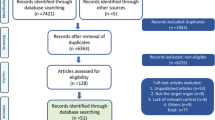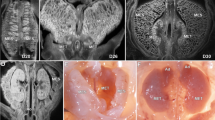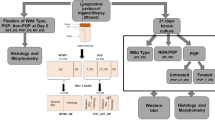Abstract
The objective of this study was to report the initial anatomic, radiographic, and genetic evaluations of a novel form of spontaneous pelvic organ prolapse (S-POP) in mice. We observed S-POP in a colony of UPII-SV40T transgenic mice developed for studies on bladder cancer. We utilized magnetic resonance imaging and necropsy to characterize this finding. We have established a breeding colony to identify inheritance patterns and for future studies. Selective breeding isolated the S-POP phenotype from the transgene. In contrast to other animal models, the S-POP mouse does not require an obligatory antecedent event to manifest pelvic organ prolapse. Necropsy and imaging demonstrate significant displacement of the pelvic organs distal to the pelvic floor in both sexes. The appearance of the POP is similar to that seen in the human female phenotype. Preliminary breeding studies indicate an autosomal dominant inheritance pattern. This mouse may be an effective animal model for the study of POP in humans.






Similar content being viewed by others
References
Bump RC, Norton PA (1998) Epidemiology and natural history of pelvic floor dysfunction. Obstet Gynecol Clin North Am 25:723–746
Subak LL, Waetjen LE, van den Eeden S (2001) Cost of pelvic organ prolapse surgery in the United States. Obstet Gynecol 98:646–661
Buchsbaum GM, Duecy EE, Kerr LA et al (2005) Urinary incontinence in nulliparous women and their parous sisters. Obstet Gynecol 106:1253–1258
Jack GS, Nikolova G, Vilain E (2005) Familial transmission of genitovaginal prolapse. Int Urogynecol J Pelvic Floor Dysfunct 20:1–4
Kim S, Harvey MA, Johnston S (2005) A review of the epidemiology and pathophysiology of pelvic floor dysfunction: do racial differences matter. J Obstet Gynecol 27:251–259
Dietz HP (2003) Do Asian women have less pelvic organ mobility than Caucasians? Int Urogynecol J Pelvic Floor Dysfunct 14:250–253
Nikolova G, Lee H, Berkovitz S et al (2007) Sequence variant in the laminin γ1 (LAMC1) gene associated with familial pelvic organ prolapse. Hum Genet 120:847–856
Visco AG, Yuan L (2003) Differential gene expression in pubococcygeus muscle from patients with pelvic organ prolapse. Am J Obstet Gynecol 189:102–112
Kramer L, Gendron J, Pierce L et al (2006) Magnetic resonance imaging of the levator ani in the squirrel monkey: a comparison of muscle volume between a cohort with pelvic organ prolapse and matched normals. Am J Obstet Gynecol 194:1467–1471
Mattson J, Kuehl T, Yandell P et al (2005) Evaluation of the aged female baboon as a model of pelvic organ prolapse and pelvic reconstructive surgery. Am J Obstet Gynecol 192:1395–1398
Zhang ZT, Pak J, Shapiro E, Sun TT, Wu XR (1999) Urothelium-specific expression of an oncogene in transgenic mice induced carcinoma in situ and invasive transitional cell carcinoma. Cancer Res 59:3512–3517
Johnson AM, Conover DL, Huang J, Messing EM, Ning R, O’Connell MJ, Rossi MA, Sun TT, Wood RW, Wu XR, Reeder JE (2006) Early detection and measurement of urothelial tumors in mice. Urology 67:1309–1314
Weber AM, Buchsbaum GM, Chen B (2004) Basic science and translational research in female pelvic floor disorders: proceedings of an NIH-sponsored meeting. Neurourol Urodyn 23:288–301
Birch C, Fynes MM (2002) The role of synthetic and biologic prostheses in reconstructive pelvic floor surgery. Curr Opin Obstet Gynecol 14:527–535
Liu X, Zhao Y, Gao J et al (2004) Elastic fiber homeostasis requires lysyl oxidase-like 1 protein. Nat Genet 36:178–182
Drewes PG, Yanagisawa H, Starcher B et al (2007) Pelvic organ prolapse in fibulin-5 knockout mice: pregnancy-induced changes in elastic fiber homeostasis in mouse vagina. Am J Pathol 170:578–589
Xiaoqing L, Zhao Y, Pawlyk B (2006) Failure of elastic fiber homeostasis leads to pelvic floor disorders. Am J Pathol 168:519–527
Connell K, Guess M, Chen H et al (2008) HOXA11 is critical for development and maintenance of uterosacral ligaments and deficient in pelvic prolapse. J Clin Invest 118:1050–1055
Acknowledgment
RWW and SDK were supported by a grant from the National Institutes of Health (DK075036-01A2).
Author information
Authors and Affiliations
Corresponding author
Rights and permissions
About this article
Cite this article
McNanley, A.R., Johnson, A.M., Flynn, M.K. et al. Inherited pelvic organ prolapse in the mouse: preliminary evaluation of a new murine model. Int Urogynecol J 20, 19–25 (2009). https://doi.org/10.1007/s00192-008-0723-7
Received:
Accepted:
Published:
Issue Date:
DOI: https://doi.org/10.1007/s00192-008-0723-7




